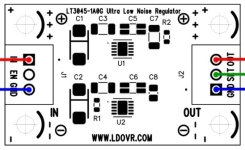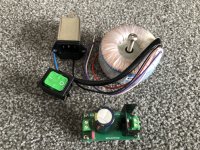Hi everyone,
I admit that I am quite inexperienced in electronics.
I'm assembling a power supply for my DAC using this LDO in order to replace the original wall adapter that is dead (so the DAC already integrates its regulation).
Upstream I already use a 19v DC source (notebook power supply).
I need to understand if it is suitable to be used as is or if it is necessary to add some bulk capacitance to the output.
These are the already built-in SMD components:
X2 LT3045EMSE
X2 Cap Tant Solid 26uF 25V C CASE 10%
X4 Cap Ceramic 10uF 25V X7R 10%
X2 Cap Ceramic 4.7uF 25V X7R 10%
X2 Res Thick Film 0603 1% 0.1W
The doubt came to me because the same manufacturer sells a more ready-to-use version where you can see two additional capacitors.
If anyone could point me in the right direction, I thank you in advance.
I admit that I am quite inexperienced in electronics.
I'm assembling a power supply for my DAC using this LDO in order to replace the original wall adapter that is dead (so the DAC already integrates its regulation).
Upstream I already use a 19v DC source (notebook power supply).
I need to understand if it is suitable to be used as is or if it is necessary to add some bulk capacitance to the output.
These are the already built-in SMD components:
X2 LT3045EMSE
X2 Cap Tant Solid 26uF 25V C CASE 10%
X4 Cap Ceramic 10uF 25V X7R 10%
X2 Cap Ceramic 4.7uF 25V X7R 10%
X2 Res Thick Film 0603 1% 0.1W
The doubt came to me because the same manufacturer sells a more ready-to-use version where you can see two additional capacitors.
If anyone could point me in the right direction, I thank you in advance.
Attachments
Last edited:
Hi, you won't need added bulk caps but you would need a transformer, rectifier bridge and filter cap (value dependent on drawn current or 4700 µF/A for LDO regs). This assuming the original PSU was a SMPS. You will need a way to transform 115V AC mains voltage to a usable low voltage DC to the LDOVR product. It is therefor an incomplete solution it seems.
This product is a quite good all in one PSU that only needs the transformer:
https://www.ldovr.com/product-p/tps7a4700-spsu.htm
You did not mention desired DC voltage but you can use the same voltage AC as the desired DC output voltage or slightly higher i.e. a 6V transformer for 5V DC output. For higher output voltages one better uses AC = DC voltages so 9V transformer for 9V output etc. Starting from 12V onwards one can even use slightly lower AC voltages. I use an 11V transformer for 12V output with LDO regulators.
Choose a transformer with a current rating minimal about 1.5 x the actual drawn maximum current.
This product is a quite good all in one PSU that only needs the transformer:
https://www.ldovr.com/product-p/tps7a4700-spsu.htm
You did not mention desired DC voltage but you can use the same voltage AC as the desired DC output voltage or slightly higher i.e. a 6V transformer for 5V DC output. For higher output voltages one better uses AC = DC voltages so 9V transformer for 9V output etc. Starting from 12V onwards one can even use slightly lower AC voltages. I use an 11V transformer for 12V output with LDO regulators.
Choose a transformer with a current rating minimal about 1.5 x the actual drawn maximum current.
Last edited:
I forgot to specify that upstream I already use a 19v DC source (recycled notebook power supply).
So I use the regulator to make DC-DC output at 15v ultra clean.
So I use the regulator to make DC-DC output at 15v ultra clean.
Yes you forgot 🙂 Please note that the 19V SMPS may be noisy and riddled with RF. Possibly you will need extra filtering to filter that out a much as possible as even the best regulators let that through.
A mains transformer with real mains switch may be safer and have cleaner voltage and it will not pollute mains voltage as much as an SMPS either. Energy consumption also will be 0 when switched off and there will be no risk of fire when you are not at home which are all very nice benefits. You are located in Japan which means you have access to wonderful top class R-Core transformers by Kitamura Kiden! http://kitamura-kiden.co.jp/product/rcore/
Whatever solution you choose, make sure it can handle the current as drawn by that DAC. LT3045 based PSUs have the drawback that their absolute maximum input voltage is close to the SMPS output voltage which may lead to issues when that SMPS overshoots at power on. TPS7A4700 won't have that issue.
A mains transformer with real mains switch may be safer and have cleaner voltage and it will not pollute mains voltage as much as an SMPS either. Energy consumption also will be 0 when switched off and there will be no risk of fire when you are not at home which are all very nice benefits. You are located in Japan which means you have access to wonderful top class R-Core transformers by Kitamura Kiden! http://kitamura-kiden.co.jp/product/rcore/
Whatever solution you choose, make sure it can handle the current as drawn by that DAC. LT3045 based PSUs have the drawback that their absolute maximum input voltage is close to the SMPS output voltage which may lead to issues when that SMPS overshoots at power on. TPS7A4700 won't have that issue.
Last edited:
You can clean up normal-mode noise from a laptop brick with LC filtering. Common-mode noise though is very difficult to filter out which is why normal (mains frequency) trafos are generally preferred where audio quality is paramount.
If you intend to use smps, use mark's filter. But as stated above, you will benefit a lot from transformer and bridge. It doesn't have to cost a lot.
You mean that laptop power supply plus such an LDO isn't already much better than the original smps?
However, ignorant question. If I need 15v DC out of the ldo, do I have to put necessarily >15v on the input?
However, ignorant question. If I need 15v DC out of the ldo, do I have to put necessarily >15v on the input?
As Jean said above, reg will let the filth trough. You can use marks filter to filter out most nm noise, but you still have cm noise. So best way is to use transformer and bridge, to supply dc to that regulator.
Yes, you need vin to be higher than vout. In ldo regulators, it doesn't have to be a much higher difference, but it still must be there. The higher vin the more heat.
Yes, you need vin to be higher than vout. In ldo regulators, it doesn't have to be a much higher difference, but it still must be there. The higher vin the more heat.
1. You will only know for sure by measuring. Not by assumption. However the vast majority of consumer grade SMPS is not clean. They are cheap.
2. No linear regulator can work with 15V at the input to produce 15V output voltage.
Choosing SMPS for low power audio applications is like cutting your finger deliberately only to be able to stick a nice band aid (the filter) on the wound but the band aid won’t heal the wound.
It is more efficient to not cut your finger.
2. No linear regulator can work with 15V at the input to produce 15V output voltage.
Choosing SMPS for low power audio applications is like cutting your finger deliberately only to be able to stick a nice band aid (the filter) on the wound but the band aid won’t heal the wound.
It is more efficient to not cut your finger.
Last edited:
Ok, thank you all for the valuable advice.
What cheap rectifier bridge do you recommend? Is there anything from China?
What cheap rectifier bridge do you recommend? Is there anything from China?
Ok, thanks for the clarification.
As for the transformer, I already have an r-core with double output 0-12v and 0.83A.
Can I put the two outputs in parallel to increase the available current?
As for the transformer, I already have an r-core with double output 0-12v and 0.83A.
Can I put the two outputs in parallel to increase the available current?
You mean simply put 0v with 0v and 12v with 12v ?
Or do I have to see if there is some small phase shift between the two windings?
Or do I have to see if there is some small phase shift between the two windings?
Please measure the voltage under load as it might be too tight. Let’s say it puts out 13V at 0.25A. That will be slightly over 15V with an assumed ideal rectifier and then there are the (bummer) real life diodes voltage drop and ripple voltage.
No go I think. 12V output is possible. Schottky rectifiers and 4700 uF for 0.25 to 1 Ampère current. For a quality LPS you can use the stuff as pictured with a 15V R-Core transformer. A 2 x 7V (in series) will be better as 15 x 1.41 = 21V. The art is to have headroom and little loss to heat at the same time.
No go I think. 12V output is possible. Schottky rectifiers and 4700 uF for 0.25 to 1 Ampère current. For a quality LPS you can use the stuff as pictured with a 15V R-Core transformer. A 2 x 7V (in series) will be better as 15 x 1.41 = 21V. The art is to have headroom and little loss to heat at the same time.
Last edited:
What about this rectifier board with 18VAC input transformer? Can go? It seems the output voltage is adjustable so I can play with it.
Next I can put LT3045 with at least 2v delta to have better PSRR.
Next I can put LT3045 with at least 2v delta to have better PSRR.
- Home
- Design & Build
- Parts
- LDO bulk capacitance?

